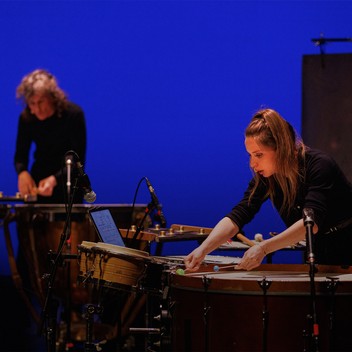Concert
POETICA

Composer Chaya Czernowin plunges us into the depths of her imagination and introduces us her new piece, POETICA. She takes us on the discovery of her creative process and artistic philosophy.
CHAYA CZERNOWIN : POETICA is not exactly about “cohesion”. It is more like a layer, inside a layer, inside a layer..., in some kind of consciousness. Or rather, it is like a sort of terrain, which would be constituted of many layers of rocks: a topological space. What we are dealing with in POETICA is not actually archeological, of course, but it is about exposing these layers. In that sense, this piece is kind of a sister-piece to HIDDEN, a quartet with electronics. HIDDEN was, in a way, comparable to going down into the depths of water, whereas POETICA symbolizes going down into the shadows of words, into the shadows of finding meaning. It all started with the notion of memory, because memory is a very complex layered system within our consciousness. Some memories are hidden from us – traumatic memories – while others are more approachable, and some others are constantly changing, because we forget, and we reshape them under the external influence of other people. Memory is something that is very fluid and not fixed. For a long time, we believed that memory was like a sort of cabinet that we physically kept locked somewhere in our brain and that we could open to access it. Of course, that is not how it works, as science has later shown. Memory is constantly active, fluid and changing.
© Klaus-Gigga, Hellerau
C.C. : There are no really lyrics, per say. The piece has more to do with the interaction between memory and the present. First, we have the soloist, Steven Schick – a genius percussionist – then the four members of the Percussions de Strasbourg who are surrounding him, and finally comes a very mysterious ensemble constituted of three strings which are hidden, away from the stage. Although this decision was originally made due to space constraints to make the piece more functional, it eventually became one of its most interesting parts. It shows just how some constraints can end up turning into the biggest asset of a piece.
What I mean when I say that the trio is “hidden”, is that we don’t know they exist: in fact, they are not even always there. They are forced into being through the play of the percussions.
C.C. : We could not get the result we were looking for by only using the sound produced naturally by the strings. So, we had to tweak their sound so that it amplified that of the percussions while also seeming like the strings were present within the percussions’ consciousness, as though they were an organic, thinking being. I am opening a kind of psychological arena, where we have the soloist, the percussions and the strings. The soloist manifests itself by his breathing. In a way, you can say that the whole piece is just like one long breath.
C.C. : I would say it really became a performance. But it is very elemental, using the minimum needed. Just like when we breathe, without even being aware of it. Breath is life, the whole universe itself is breathing, contracting. It is the same with POETICA.
C.C. : It is very operatic indeed. You could call it the “opera of breathing”, or the “opera of the breath”.
© Klaus-Gigga, Hellerau
C.C. : I would say it is more about a communication between the layers that constitute the piece, as we go down into consciousness. It is about connecting the different spaces within one mind. But this “opera of the breath” is also suggesting a certain objectivity because, while this internal conversation is going on, we can also hear the sounds of demonstrations. I was there during the demonstrations that took place in Paris and Tel-Aviv, and I have also been watching TV here in America. So, I decided to record them, adding some other sources as well. These recordings bring an external dimension to the piece and give the impression that the ensemble is trying to survive from the burning of the world. Because, when we think about it, what are demonstrations really about? It is nothing more than a gathering of thousands of people clamoring about things they are defending or fighting against. What we hear are therefore the screams of an unhappy world, which has no control over the constant changes it is facing. And in this world which is hurting us, we have to fight to remain human. Just like we do when we are focused on our breathing – how it goes up and down, like a meditative act, in the face of a changing and treacherous world.
C.C. : In the past, it was considered that the field of music was constituted of three different categories: processes, spaces and events. Now, we are realizing that there is no such a dialectic division, and that these categories are more on a continuum. When we are in a space, even though it is cyclical, like breathing, there is a very slow process that is sneaking into the breathing, making it deeper, heavier. It then becomes more difficult to breathe despite the process in itself not being difficult, and it can take some time before we realize that something has changed. The speed (or here, slowness) depends on how invested we are in the space or the process. A fast-paced development brings us to the completion of the process, whereas a slow development takes us into the spatial dimension. Space is never solid, or fixed, it is always changing. What is fixed is rather the notion of time scaling, which is something very important to consider as well.